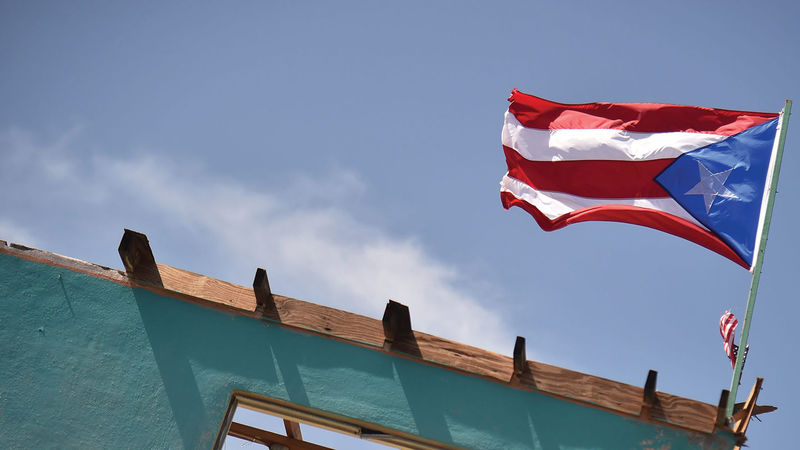When Gilberto Marxuach-Torrós ’88 came to work on Friday, September 15, things were still relatively normal. Down the hallway from the office Marxuach occupies as president of San Juan, Puerto Rico’s University of the Sacred Heart — Universidad del Sagrado Corazón, or “Sagrado” in local parlance — keyboards clacked and phones rang with the everyday work of running a school of 4,000 students.
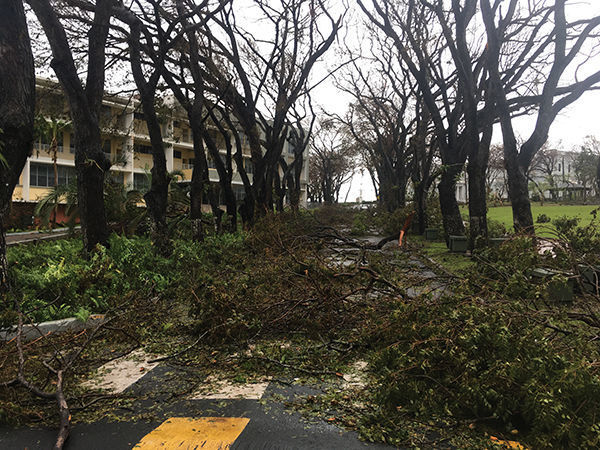
Air conditioning systems whirred quietly across the 33-acre urban campus as students bounced from study sessions in Madre María Teresa Guevara Library to classes in the school’s gargantuan academic buildings, Barat Norte and Barat Sur. As iguanas sunbathed on the sidewalks, faculty members held office hours or led students to visit the new show at the campus gallery by art collective Y No Había Luz — And There Was No Light.
For many, it would be the last time they would see their office or attend an indoor class for the rest of the semester. By Monday, September 18, a major hurricane was headed for the island.
One month into the academic year, Marxuach had already dealt with a destructive storm. Hurricane Irma had clipped the island’s northeast corner on September 5, causing damage that forced Sagrado to suspend classes for seven days.
This new storm, Maria, showed signs of being worse. At Sagrado’s pastoral center, Sister Madeline Ortiz and her team rushed to re-earmark Irma relief donations for the inevitable new wave of Maria victims. The university preemptively canceled classes for the week and instructed Puerto Rican students to go home and prepare to ride out the storm with their families. Pedro Fraile, dean of student affairs, helped the 500-odd residents of Sagrado’s two dorms to move out and the school’s international students — 103 after the arrival of a group of nursing students two days before the storm — to move in.
Anticipating that communications systems could fail after a direct hit, President Marxuach gave his staff a directive: After the storm, whenever it’s safe, come back to campus. If we can’t touch base with phones and computers, we’ll reconnect in person.
As academic operations wound down, students, faculty and staff headed home to all corners of the Connecticut-sized island to settle in. Silence fell over the campus as it often would on a weekend, but this quiet, accentuated by storm-shuttered windows and empty parking lots, seemed different.
“Normal” was over. Maria was on her way.
Flying into the United States territory of Puerto Rico in November, nearly two months after the hurricane, the first thing I noticed was the mountains. I knew the island was small, but the peaks seemed to stretch on forever anyway, row after untidy row of jagged green teeth that looked as though the ocean had spit them out onto the shore.
The Cordillera Central is wild, I thought, and as I stared out the window something else came into view: houses. Not occasional chalets or isolated cliff-side mansions, but whole communities hidden among the tree-covered peaks, nestled in tiny valleys or balanced on slopes. Those mountains teemed as much with human life as with trees.
But these houses were unusual. As the plane descended into Luis Muñoz Marín International Airport and the sprawling capital came into focus, I registered that too many of these buildings had blue roofs. I wrote it off at first as an architectural choice. Then I realized that the blue roofs weren’t roofs at all. They were government-issued tarps.
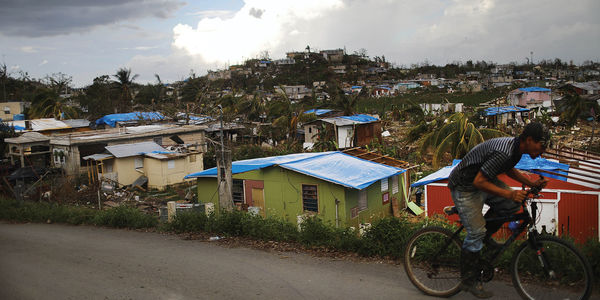 Photo by Mario Tama/2017 Getty Images
Photo by Mario Tama/2017 Getty Images
Riding through the city to Sagrado’s campus, I saw that the stoplights were still not working. The main highway cutting through San Juan was lined with jumbled knots of metal siding, tin roofs and twisted traffic signs. Downed electrical poles lay in the streets every few blocks.
Up close, it was easier to see the damage to the trees, their gnarled branches and toppled trunks, the sheer volume of olives and palms that had lost their leaves. It felt like autumn in the Midwest — until I opened the car door to 88-degree heat and remembered that, on tropical islands, the leaves aren’t supposed to fall.
On Friday, September 22, the morning after Maria sliced through the island, Sagrado’s administrators and staff followed their pre-storm instructions and began trickling onto campus, arriving to find a university so cluttered with debris that cars could only enter through the back gate.
“Our priority was, we have to open the university,” Marxuach says, recalling student concerns that the destruction would wipe out the entire fall semester. “You wanted to get the front gates to be able to open, just to tell everybody, ‘Come. We’re open.’” And they did.
By 10 a.m. that morning, a six-person team had assembled, Marxuach and Fraile among them. They walked the grounds, clearing standing water from the rooftops of buildings and removing trees from the roads. By the end of the first day, they were able to pry open Sagrado’s front gates.
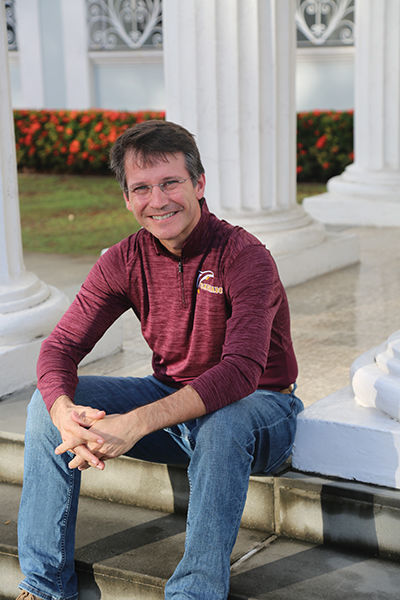 Gilberto Marxuach-Torros ’88
Gilberto Marxuach-Torros ’88
“We didn’t even clean it,” Marxuach remembers. “We just pushed everything aside so a car could come in, in the middle of the street, and drive up.”
Even as the university celebrated its first recovery milestones, the needs of its neighbors and students were beginning to surface.
One nearby storm shelter had called just hours into the recovery effort, asking if the university had any volunteers to spare for their understaffed team. As staff members and students returned to campus, they told stories of damaged homes and suffering loved ones. Then, about a week into the recovery, José Carlos Sánchez arrived.
The usually bubbly and charismatic senior, a former president of Sagrado’s student council, looked tired when a group of administrators spotted him in the university’s 111-year-old main building. Marxuach asked how he was doing.
“Necesito ayuda,” the young man replied. I need help.
Sánchez had returned to campus from his hometown of Barranquitas, a municipality of 30,000 in the center of the island. He had been one of the first people who found a way to leave the city, clearing roads as he went and hitching rides to make the journey out of the mountains and into the capital. His family emerged shaken but unharmed after the hurricane, but many in his community weren’t so lucky. Barranquitas needed help. Could Sagrado provide it?
After Hurricane Irma, the university’s pastoral center had launched an initiative called Sagrado Contigo — Sagrado With You — to distribute aid to affected off-campus communities. Plans were already in place to resurrect the program for Maria victims, but officials soon realized that the work of helping students and neighbors would be as crucial to recovery as the effort to repair the campus.
Disaster relief was proving slow to arrive on the island, but Sagrado had a growing pool of donations from alumni, charities and local businesses, and a strong network of nonprofit partners. If federal assistance wasn’t forthcoming, officials decided the university would simply become a relief agency.
Sagrado Contigo initially comprised three branches — aid to students, aid to faculty and staff, and aid to hard-hit communities in the Santurce neighborhood surrounding campus — but Maria necessitated a fourth branch that would take Sagrado’s efforts island-wide. In response to the unprecedented damage and the harrowing stories from students like Sánchez, the university would go beyond replanting campus trees and delivering water down the street. Inside the relief distribution center that sprang up in the university gymnasium, a new goal emerged: serve people in need in every one of Puerto Rico’s 78 municipalities.
All told, the National Hurricane Center lists Maria as the 10th-strongest Atlantic hurricane in history. The storm pummeled Puerto Rico with sustained winds of up to 155 miles per hour and dumped some of its highest-ever rain totals, peaking at 38 inches in Caguas, a city 20 miles south of San Juan. Estimates place the potential economic impact of the storm at more than $90 billion, and environmentalists say it will be decades before the island’s forests and farmlands recover.
Hurricane Maria made landfall on Vieques, a small island municipality off the east coast of Puerto Rico, as a Category 4 storm, and lost little of that strength as it barreled across the rest of the U.S. territory. It formed floodwaters up to 15 feet deep, severely damaged the famous Arecibo Observatory and destroyed a Doppler radar device in San Juan that had just reported winds of 145 miles per hour.
The storm knocked out power to all of the island’s 3.4 million residents. By year’s end, the official death toll stood at 64, but journalists were reporting what community leaders long suspected. Accounting for increased cremation rates, missing persons reports and deaths in which the storm may have played a secondary role, the true count could be more than 1,000.
On the American mainland, it’s hard to imagine a single storm so thoroughly devastating an entire state. It used to be hard to imagine in Puerto Rico, too — until, thanks to Maria, it wasn’t. Unlike previous hurricanes, Maria didn’t hit just here or there. The rectangular island measures about 40 miles wide from north to south. As Maria slammed into its southeast corner, its hurricane-force wind zone stretched nearly 60 miles. The eye cut straight through the center of the island, exiting in the northwest as the strongest storm most Puerto Ricans have seen in their lifetimes.
Many schools remained closed for six weeks or more after Hurricane Maria, but Sagrado decided to resume classes on October 16 — an ambitious decision that the staff attributes to the university’s president.
After graduating as valedictorian of his class at Notre Dame and earning a law degree at Yale, Marxuach returned to his native Puerto Rico in the 1990s to serve as a law clerk in the territory’s Supreme Court. He spent years in private practice, served in the territorial governor’s office as chief legal counsel and later led a consulting firm, all the while harboring a desire to give back to his home through education.
When the presidency opened four years ago at Sagrado, one of the island’s premier Catholic universities, Marxuach jumped at the opportunity — and what he lacked in administrative experience, he more than made up for in accessibility and commitment to his students.
Doris Báez, the coordinator of Sagrado’s volunteer center, says she has seen students walk directly up to Marxuach, tell him what they need and wait for him to deliver, because they know he will.
“I don’t think there are that many universities that respond to that,” she says. “It wasn’t my experience as a student. I knew who the president was. I knew he existed. I saw him once in a while, in a theater, down there somewhere, speaking.”
But many of Sagrado’s students know their president personally. Students will say hi or chat about the basketball team when they see Marxuach at Mass or in the dining hall. They feel they can talk to him — all the more so now, after the storm.
A day after the hurricane, Marxuach says someone tapped him on the shoulder at an emergency shelter where he was volunteering and said, “Presidente.”
The young woman identified herself as Victoria, a second-year student, and said she was living with her family in the shelter after they were forced from their home.
“We lost everything,” she said. “But I want to continue studying.”
Marxuach gave the student his cell phone number, put her in touch with her professors, and returned to campus to prepare an aid package for the family. Then he talked to the provost, María Teresa Martínez.
“That was kind of an inspiration for everything that happened later,” he says. While Marxuach and a team of 150 student and staff volunteers focused on restoring campus, he assigned Martínez and her staff a different task: Save the semester.
The provost’s team worked tirelessly to build a new schedule around natural light and ventilation. The classroom buildings were too large for the university’s generators to support, and the staff prudently anticipated that grid power might stay off for the foreseeable future. Instead of stuffy classrooms and science labs, classes would be held in any space that could accommodate 25 people, draw a breeze and use the sun for illumination. Gazebos, hallways and even the campus chapel were pressed into service. Tents went up around campus to accommodate the rest.
Campus wasn’t normal — it won’t be for a long time — but it was functioning, just as students like Victoria had asked.
“The reaction from the students was great, because they had a place to gather,” Marxuach says. “They knew their future was going forward. They had a place to tell their stories.”
At home, students might not have power, water or a roof, let alone internet access. In Sagrado’s makeshift student center, an indoor-outdoor space comprised of transplanted dining-hall tables and chairs made of pallets taken from relief donation trucks, they had all four of those basic amenities. Living at home might mean spotty access to hot meals; returning to school meant two a day, which students could even get for free at the pastoral center, no questions asked.
The hurricane caused other campus problems. By November library books remained imperiled in the Caribbean humidity. Around 10 percent of the student body had yet to report. But those who had come back, even intermittently, found good things happening despite the downed trees and classes in tents.
“The university started working,” Marxuach says. “But it was a totally new university, because now everybody was on the same level. Everybody was dealing with the same challenges.”
In this egalitarian environment, another change emerged: a renewed spirit of volunteerism.
More than 450 students have volunteered with Sagrado Contigo since the storm. Carmen Chazulle, the director of the Community Engagement Center, says service learning has always been a part of life at the school, both in the curriculum and in students’ free time — but the efforts after the hurricane have been different.
International students, left unharmed by the storm but without power in their residence hall, volunteered just to have something to do. Before they could even tell their parents back home they were okay, many ventured out across the island, becoming some of the student body’s first relief volunteers.
Edoardo Zorzin, an Italian exchange student, says his parents were worried. “But they never thought, ‘My son wants to come back.’ And I told them, ‘I don’t want to come back. I want to stay here, and help here.’”
Other students volunteered because they wanted to help their own towns, or the towns where their friends live. Still more stepped forward because their professors were donating their expertise. Art teachers designed craft projects for schoolkids still stuck at home. Nursing instructors ran health clinics. Their students wanted to join in on these meetings of classroom and community.
Sagrado Contigo’s efforts were — and still are — wide-reaching. Its services range from the distribution of food and water to mental health screenings by school psychologists to assistance filling out Federal Emergency Management Agency (FEMA) relief forms, with each volunteer outing tailored to a community’s specific needs.
Some towns need more help than others.
The road to Barranquitas is bumpy on a good day. With four-wheel drive and a bit of confidence, anyone could make the 34-mile journey, but it requires some deft maneuvering, particularly for a large vehicle like a school bus or a semitrailer delivering aid supplies.
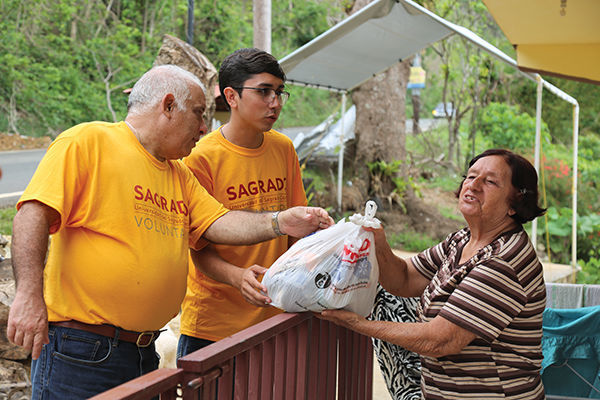 Sagrado students distributed water and care packages across the island, including the hard-hit town of Barranquitas, home to student council leader Jose Carlos Sanchez (center).
Sagrado students distributed water and care packages across the island, including the hard-hit town of Barranquitas, home to student council leader Jose Carlos Sanchez (center).
When I visit with two busloads of Sagrado volunteers on November 14, the drive takes around two and a half hours. Our bus driver honks as he rounds the many tight curves along the way, alerting oncoming cars to leave room on the not-quite-two-lane road. We hit rush hour in nearby Corozal, where the line of cars dropping off kids at Colegio Sagrada Familia overwhelms the main street, a crumbling byway not designed for modern traffic flow.
In Barranquitas proper, the hairpin turns and pothole-ridden roads are worsened by perilously hilly terrain, with enough ups and downs to transform our driver from friendly volunteer chauffeur into motorized mountain climber.
Such challenges could explain why Barranquitas did not see a FEMA aid delivery for more than a month after Hurricane Maria, but they didn’t dampen the efforts of Sagrado Contigo volunteers, who mark their third visit in eight weeks with this trip.
José Carlos Sánchez, the student council leader and native Barranquitan, has helped organize our day, just as he had spearheaded most of the recovery efforts in town, working with his family to solicit donations from nonprofits and direct volunteer organizations on where and what to deliver. It’s an arduous task for a college student, because Barranquitas — a remote and impoverished town to begin with — was particularly hard hit.
The mountain streams that crisscross the city flooded as far as 10 feet beyond their shallow banks. Mudslides cascaded down the hillsides, blocking roads and cutting off access to entire neighborhoods. In a community where structures are built of more varied and unstable materials than the concrete used in San Juan, untold numbers of homes and businesses were badly damaged or completely destroyed.
When I arrive, the floodwaters have receded. People have taken to the mudslides with shovels and backhoes, pushing the bulk to one side of blocked roads and leveling the mounds so cars may at least drive on the street in one lane and on smoothed-out dirt in the other. Recovery has begun, but only in the most elementary ways.
We start our day with a program at Escuela Inocencio Cintron Zayas, a Montessori school named for Sánchez’s grandfather. Sandra Pomales, the university’s communications director, nudges me and points to a line of discoloration on the building’s second story where the flood crested after the storm. Sánchez points out a house overlooking the river next to the school where, he says, an elderly woman had to be evacuated by mountain trail after rising water cut off all direct access to her home.
As the Sagrado team sets up in the schoolyard for the morning program, a homemade banner posted to a clump of fallen trees flutters in the wind:
AFECTADOS, INCOMUNICADOS, OLVIDADOS. Dia 53 Maria. Nadie de pues.
Affected. Isolated. Forgotten. Day 53 after Maria. Nobody since then.
School has resumed at Cintron Zayas — earlier than any other school in Barranquitas — and as kids and parents gather it almost seems like an ordinary school assembly. Children line up to watch a woman in overalls and a bucket hat read from picture books. Parents hover in the back, snacking on rice and beans from the buffet line and keeping a watchful eye on their kids.
The only things shattering the illusion of normalcy are the aid stations. Along one side of the yard, students unpack boxes of food, water and hygiene products. A team of massage therapists stands near two tables, waiting to offer their free service to any parent or teacher who comes by. Across the lawn, nursing students set up tables for blood pressure checks and health screenings. Another station is covered in brochures from FEMA and the federal Centers for Disease Control and Prevention: “Tips for Preventing Leptospirosis.” “How to Apply for Disaster Relief.”
As Shabum, a Sagrado alumnus famous as a children’s magician on Telemundo Puerto Rico, starts a magic-trick set, I climb into a minibus with 11 other volunteers to begin a series of door-to-door deliveries.
The bus, filled to the brim with bottled water and packages of rice and canned goods, bounces along behind Sánchez, who’s navigating from the passenger seat of his friend’s Kia. We have a set route through the town’s most remote neighborhoods, but Sánchez halts the caravan every time he sees someone on the side of the road. In the front of the bus, Dean Fraile sighs with each stop, but he hands food and water out the window anyway. Sánchez’s goodwill may be making us late, but it’s still goodwill.
When the bus finally reaches its first preselected neighborhood, we each grab a few bags of food and set off on foot down the road.
“Buenas tardes!” the students shout, looking for anyone who’s home to receive a delivery. “Buenas!”
Despite our arrival during school hours, many people come to the door with kids in tow, or send their children — still at home because school has not reopened, or because it’s too perilous to get there — to greet us. These youngest aid recipients are won over quickly when they spot our bus seat full of peluches — giant, fluffy teddy bears that are theirs for the taking.
Our yellow Sagrado Voluntario t-shirts announce why we’re there, but wherever we get a response, the students explain that we’re from Universidad del Sagrado Corazón in San Juan, and we have food, water and diapers to give away.
Given my bad Spanish, I stick to the easy question — “Necesitas baterias?” — and to relaying answers back through the assembly line: “They need doble-A.”
The bus follows the 12 of us through town, up calf-busting hills and around downed power lines, as we slowly give away every supply in the stack. The mountain views, though tarnished by tree damage, are stunning, and we regularly stop for pictures. At one house, Fraile accidentally gives a young mother our entire bag of batteries instead of a bag of food, sparking laughs from everyone. Spirits high, Sánchez — the least experienced English speaker in the group — teases me about my Spanish. Everyone makes fun of his English.
People are reluctant to come out and greet us at first, but, with time, nearly every house where the owners aren’t fortunate enough to be at work sends someone to the gate. No one wants to admit they need help from a bunch of sunny college kids, but with the state of things in Barranquitas, no one can afford to turn down bottled water or batteries, either.
In two hours of visits, we find only four houses with working generators.
If you travel to Puerto Rico right now, you should expect that the power might go out. It did on November 15, knocking the island back to 22 percent power regeneration one hour after the governor had announced that the percentage of Puerto Ricans with power had just passed 50.
Should you visit a Puerto Rican home for dinner, your hosts will likely cook for you on a camp stove. As days of living on generator power have stretched into weeks and months, many families have opted for this kerosene-fueled alternative.
Going to the beach is a no-no amid sanitation worries, and you may want to call ahead to ask if your restaurant has power. The government’s goal in October was for 95 percent of the island to have electricity by December 15. By November, the reality was obvious: No way.
In short, you should expect to witness an American humanitarian crisis, because that’s what this storm has created.
Sagrado history professor José Martínez-Borrás says Maria illuminated an injustice that is a longstanding part of Puerto Rican life: U.S. citizenship without representation by a voting member in Congress. Ports controlled by draconian maritime laws. Electrical systems built by an unelected governor 70 years ago and barely updated since.
“This is a human rights issue and a civil rights issue,” Martínez says. “The civil rights movements of the United States didn’t die in the ’60s. This is part of that movement.”
Maria’s waves will continue to have ripples at Sagrado, too. Some students will leave the island for good, like the tens of thousands of Puerto Ricans who have fled to the mainland since the hurricane. If the students who haven’t yet reported don’t return for the spring semester, adjunct professors will likely see reductions in their course loads or lose their jobs altogether.
For now, though, hope survives at Sagrado and in the neighborhoods and towns the university has served. Breezes cool the improvised student center, where, under generator-powered lights, students read or watch Netflix. Neighborhood parents relax over Cokes during their kids’ swim practice in the nearby pool. Mainland and Puerto Rican pop songs blare from competing radios while volleyball players hit practice digs off the wall, carefully avoiding a taped-up map of the school’s temporary classrooms.
Beyond the gates on the north end of campus, a massive Puerto Rican flag flies high above the Baldorioty de Castro Expressway and the distant ocean. A post-hurricane slogan is splashed across the lowermost white stripe: #PRSeLevanta.
Puerto Rico is rising. And Sagrado is rising right along with it.
Sarah Cahalan is an associate editor of this magazine
